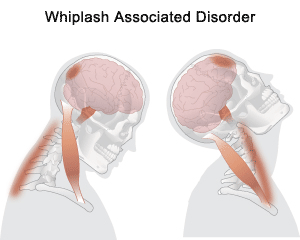Medical Library
Loading...Please Wait
Whiplash Associated Disorder

Whiplash or Whiplash Associated Disorder (WAD) - a "whiplash" is the term that describes the sudden forward and backward movement of the head and neck most commonly occurring during a motor vehicle accident. It can also occur during a variety of other activities such as recreational and competitive sports. Note that a whiplash could also occur with a rapid side-to-side movement as well.
WADs are estimated to cost consumers and the insurance industry billions of dollars each year. With a WAD there can be soft tissue injury, bone fracture, and nerve damage. Because of the considerable number of structures (bone, spinal cord, brain, ligament, intervertebral disc, muscle, joint capsule, and tendon) involved, recover can take months or years. However, most cases of whiplash resolve in a couple months or less.
A classification of WAD was offered by the Quebec Task Force (a group that did extensive study on Whiplash):
- 0 - No complaints about the neck, no physical signs.
- 1 - Neck complaints of pain, stiffness, or tenderness only No physical signs.
- 2 - Neck complaint AND Musculoskeletal signs (decreased range of motion and point tenderness).
- 3 - Neck complaint AND neurological signs (decreased or absent deep tendon reflexes, weakness, and sensory deficits).
- 4 - Neck complaints AND fracture or dislocation.
X-rays and other diagnostics may be performed by your physician to rule out fractures.
Physical therapy can be very helpful with the recovery of range of motion, strength, endurance, and the management of pain. Soft collars are of little benefit but rigid collars may be helpful in the acute stages of recovery.
Possible Treatments
- Aerobic/Endurance Exercise

- Core Strengthening

- Cryotherapy or Cold Therapy

- Electrotherapeutic Modalities
- Heat Pack

- Isometric Exercise

- Neck Active Range of Motion

- Neck Joint Mobilization

- Neck Passive Range of Motion

- Neck Resistive Range of Motion

- Neck Traction

- Posture Training

- Proprioception Exercises

- Physical Agents
- Soft Tissue Mobilization

- Stretching/Flexibility Exercise

Possible Treatment Goals
- Improve Fitness
- Improve Function
- Improve Muscle Strength and Power
- Increase Oxygen to Tissues
- Improve Proprioception
- Improve Range of Motion
- Improve Relaxation
- Self-care of Symptoms
- Improve Safety
- Improve Tolerance for Prolonged Activities
Additional Resources
Disclaimer
The information within this Medical Library does not represent the views, opinions, advice, or treatment philosophy of E6 Physical Therapy. Any reference herein to any specific commercial product, process, or service by trade name, trademark, manufacturer, or otherwise, does not constitute or imply its endorsement, recommendation, or favoring by E6 Physical Therapy or its employees/affiliates and any such reference shall not be construed as advertising or product endorsement.